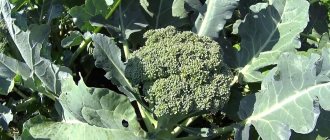If cabbage is frozen, what to do? Frozen cabbage: can it be salted?
For long-term storage, it is best to remove it from the roots. Green leaves are removed and the heads of cabbage are left under a canopy in a draft. Then the cabbage is placed in storage in one or two rows. It will be preserved better if the heads of cabbage are sprinkled with a thin layer of crushed chalk.
Cabbage is stored securely in the basement in lattice boxes or on racks. Some gardeners, guided by the proverb “Every cabbage has its own head,” wrap the heads of cabbage in paper, which successfully protects them from drying out. The heads of cabbage can be tied by stumps in pairs and hung so that they do not touch each other. There is also this method of storage in the basement: remove the top leaves from the cabbage forks and place the heads of cabbage with the stalks down in long boxes with sand, which needs to be compacted and watered occasionally.
In areas with mild winters, cabbage can be stored directly in the ground. The bottom of the grooves intended for storing vegetables is covered with straw, then the heads of cabbage are laid with the stumps up and covered with sand so that they do not touch each other. Manure is placed on top and soil is poured. To protect cabbage from rats and mice, the bottom of the ditch is sprinkled with pine needles, and the top is also covered with a thin layer of pine needles.
If the cabbage is frozen. Late cold-resistant varieties of white cabbage can withstand frosts down to minus 4 - minus 5 ° C in open ground, but cut heads of cabbage will not tolerate such temperatures. Dense heads of cabbage freeze more strongly than loose ones, in which the air accumulating between the leaves serves as a kind of heat insulator. But it is better not to expose even cold-resistant varieties to repeated frosts, as this affects them extremely unfavorably.
Before storing frozen cabbage, it is necessary to determine how deep it is frozen, since frozen outer leaves “retract” when the temperature rises, and if the core is affected, then such a head of cabbage will inevitably rot.
If the cabbage is frozen to a depth of five to six leaves, it will be stored for no more than 2.5-3 months. Such heads of cabbage should be placed separately, viewed more often and used first. But it is not recommended to ferment frozen cabbage.
However, even completely frozen heads of cabbage can be saved. To do this, they are thawed in several stages. First, the cabbage is kept for three days at a temperature of 1-5 °C, then at 10-15 °C. Of course, such cabbage cannot be stored for long periods of time, but the taste is quite acceptable.
V. SUPRUNENKO, Zaporozhye, Ukraine.
Other articles in the issue in the “Nursing Earth” section:
Any partial or complete reprint of published information is permitted only with the consent of the author.
Ways to ferment frozen vegetables
If you still have doubts about whether it is possible to ferment cabbage if it is frozen, you should familiarize yourself with the recipe for pickling such a product.
You can salt frozen cabbage for the winter in several ways:
- whole heads of cabbage;
- halves and quarters of vegetables;
- shredded sheets with the addition of spices and herbs.
At the same time, fermenting frozen cabbage is even faster than fresh cabbage. Thanks to softer sheets, the product preparation time is reduced several times. For 10 kilograms of vegetables you will need approximately 200-250 grams of rock salt. If little juice is released during ripening, you can add salted boiled water to the preparation.
Completely frozen heads of cabbage can also be suitable for pickling, unless they have begun to rot and become too soft. It is not recommended to ferment such a vegetable for the winter, but it is suitable for preparing first courses, vegetable stews, meat with vegetables, or stewed potatoes with sauerkraut.
What can be made from frozen cabbage. What to do with frozen cabbage
Cabbage is very beneficial for our body. For example, sauerkraut perfectly supports human immunity. Cabbage grows in all gardens. But sometimes, with the onset of cold weather, not everyone has time to remove the heads of cabbage and it freezes. What to do in this case?
White cabbage is a frost-resistant crop. It can withstand frosts down to -5 degrees. Loose heads of cabbage freeze less than dense ones, because the air that accumulates between the leaves serves as a good heat insulator. But even such heads of cabbage cannot withstand constant frosts.
If, however, you did not have time to cut and store the cabbage in time, and it froze, then you need to determine the depth of freezing. If only the outer leaves froze, then nothing bad happened, and they will restore their basic properties. And if freezing has reached the core, then the head of cabbage may rot.
Frozen heads of cabbage are not suitable for preparations and pickling. Therefore, you will have to store it only fresh. If the cabbage is frozen to 4-5 leaves, then it can be stored for up to 2 months. But it is necessary to inspect it regularly and store it separately from healthy heads of cabbage. Rotting can occur at any time.
You can try to save the most frozen heads of cabbage. To do this, they are kept at a temperature of +4 degrees for 2-3 days, and then transferred to a warmer place with a temperature of up to +15 degrees. After thawing, the cabbage should regain its taste. But storing such heads of cabbage is undesirable. Therefore, they are simply used for cooking.
And one more thing: vegetables that have been thawed contain a large amount of nitrates, so be careful when using them in food.
Cabbage seedlings froze. Rules of agricultural technology
Important! An incorrect approach to growing crops can lead to the death of seedlings even in greenhouses. The plant can get cold with the slightest mistake in cultivation.
Spring sowing, which takes place in early April (in warm zones - 2-3 weeks earlier), should be accompanied by hardening of the planting material. The seeds are immersed in a container of warm water. It takes about half an hour to keep them in it. After which they are slightly dried and transferred to a cool container. During the hardening process, you can carry out etching by adding a fungicide to the liquid.
After sowing seedlings in open ground, it is imperative to cover the crops with spunbond or film. This will protect the seedlings from frost in early spring. If you are afraid that the soil will freeze and the seeds will not germinate, you can sow them in cups. You can keep young plants in them until the plants become crowded.
Gradually, you can take the container with the crop outside for hardening, and later transfer it to an unheated greenhouse. Hardened seedlings will no longer be able to freeze. This method of growing seedlings is also good because there is no need to plant each potassium separately, thereby causing less injury to young seedlings.
Note! The crop is planted in a permanent place in mid-May, when the soil has warmed up well, the threat of prolonged negative temperatures has subsided and there is no longer a need to cover the crops.
The cabbage froze on the balcony. Will the crops freeze on the balcony?
Change text size:
Apples and pears
Many summer residents store their harvest on their balconies before the cold weather sets in. But when exactly should potatoes, carrots, beets, onions, apples and pears be moved to a warm place so that they do not spoil? Should I do this immediately at the first frost or can I wait a little longer?
“If the balcony is not insulated, then as soon as the thermometer begins to show a negative temperature, apples and pears need to be moved into the apartment, because they will spoil,” says Vitaly VASEKHA, senior researcher at the RUE Institute of Fruit Growing. — You can put a jar of water on the balcony: as soon as you see that the water has begun to freeze, take the fruit away, otherwise they will freeze and become loose and lose their taste. On the insulated balcony, the harvest can be stored all winter. The optimal temperature for storing apples is +2 - +4 degrees, for pears +1 - +3.
In an apartment, it is best to store apples in the refrigerator, separate from vegetables, but since most often there is no room for them, place them in boxes or nets that allow air to pass through and place them in the coolest place, away from radiators. Never store apples and pears in plastic bags, as this will significantly shorten their shelf life. In an apartment at a temperature of +18 - +20 degrees, fruit can be stored for about a month. Some apples can be frozen by cutting them into pieces to make compotes from them in winter.
Potato
One of the most convenient options is to make an insulated box for storing potatoes on the balcony. If it is not there, then in the absence of a basement or cellar you will have to look for a place in the apartment or on the corridor.
“Potatoes need to be removed from the balcony when the temperature drops to zero degrees,” advises Ivan Ivanovich KOLYADKO, Deputy General Director for Scientific Work of the Republican Unitary Enterprise “Scientific and Practical Center of the National Academy of Sciences of Belarus for Potato and Fruit and Vegetable Growing.” — Potatoes should be stored at a temperature no higher than +10 degrees, preferably +4 - +5.
Do not put potatoes in bags or bags that do not allow air to pass through - they will spoil, and do not place them in the light - they will begin to turn green.
Onion and garlic
The most persistent vegetables are onions and garlic. They can be stored on the balcony even after you have already moved the rest of the harvest into the apartment.
“The optimal temperature for storing onions and garlic is 0 - -1, but they can easily withstand frosts down to -6 degrees,” says Nikolai Petrovich KUPREENKO, deputy director for science of the Republican Unitary Enterprise “Institute of Vegetable Growing.”
When storing onions in an apartment, you can braid them and hang them in a dry place (diseases will develop in a humid environment and the onions will begin to sprout). Part of the harvest can be placed in boxes. But just don’t use plastic boxes - onions breathe and release moisture, but plastic doesn’t absorb moisture, so the harvest will spoil.
Check the contents of the boxes periodically: remove softened bulbs from the box immediately so that they do not become a source of infection for others. And do not store vegetables affected by pests and diseases - they quickly spoil.
Beetroot and carrots
They need to be taken away from the balcony at zero temperature - they are afraid of frost. The suitable temperature for storing carrots is +2 degrees. If there are only a few carrots, you can put them in the vegetable compartment of the refrigerator: there are ideal conditions for them.
There are usually no problems with storing beets. Before storing, the tops are cut off, dried, put in boxes and periodically checked how they are stored. If you notice rotten fruits, throw them away immediately.
Cabbage
Cabbage will withstand a slight frost of -1 - -2 degrees, but it is not worth keeping it on the balcony for a long time in late autumn. To keep it well, choose late maturing varieties - their heads are denser. Cabbage is stored at a temperature of plus 2 - 3 degrees and high humidity.
Preparing the product for cooking
Cabbage can freeze due to various reasons:
- sharp frosts caused the remaining heads of cabbage in the garden to freeze;
- cabbage was stored under improper conditions in a cold room: on a veranda, balcony or attic;
- low-quality frozen goods were purchased in markets and stores;
- The cabbage was specially frozen for later cooking.
Cabbage that is frozen in the garden does not need to be taken indoors immediately. It's better to wait until it gets warmer the next day. In this case, the heads of cabbage will thaw naturally and can be cut. Remove damaged leaves and use the inside for subsequent harvesting.
Move the frozen heads of cabbage on the balcony to a cool room with above-zero temperatures. Salt the thawed cabbage in the usual way.
Attention! You can also salt frozen cabbage leaves, but such preparations will be less crispy.











